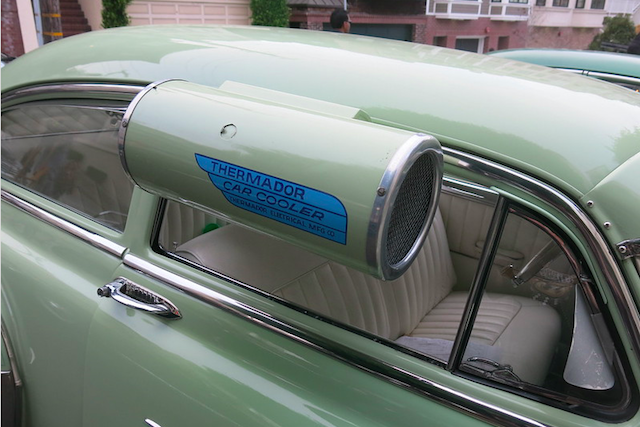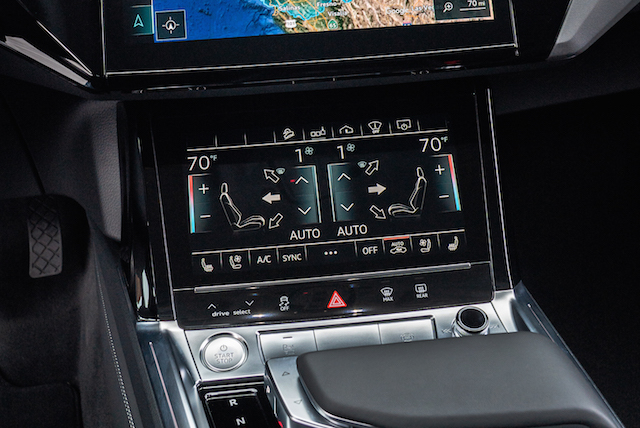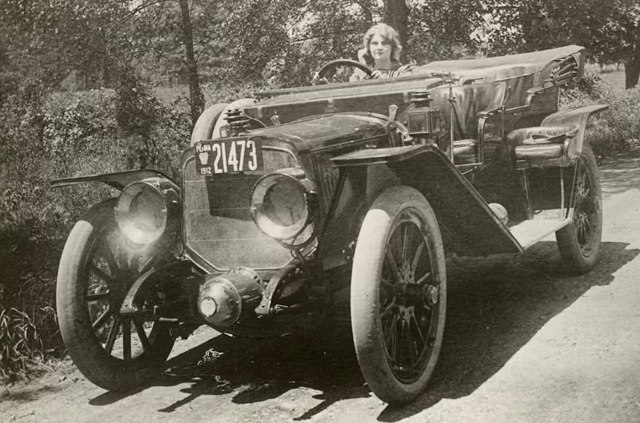Summer brings with it a host of delightful sensations – the sun’s warmth on your skin, the smell of the ocean air, and the sight of early-morning sunrises and late-evening sunsets. It also gives rise to that dreaded, uncomfortable feeling every motorist has experienced: opening your car door in the middle of a hot day only to be keeled over by the wave of heat emanating from the vehicle’s interior.
The truth is, cars get hot. Dangerously hot, actually. Fortunately, nearly every American car is equipped with standard air conditioning. But this wasn’t always the case. Modern air conditioning was invented in the early 1900s and it took several more decades to devise a way to incorporate it into an automobile.
So, how did we go from relying on open rooftops and rolled-down windows to being able to turn our car into an icebox with just the press of a button? The history of air conditioning in cars has seen quite the evolution.
Early Automotive Cooling Systems
Although air conditioning in cars was still years away, the earliest vehicles had a distinctive advantage to beating the heat: they were open air. The earliest Model T’s, for example, had no doors and a collapsible hood. Drivers were likely more concerned about cold weather.
But closed-body vehicles quickly followed. For drivers and passengers to cool down in these cars, windows were rolled down while vents under the dashboard circulated air. However, these ventilation systems were crude and didn’t keep dirt, dust, pollen or insects from getting inside the vehicle.
Other primitive cooling devices included the Knapp Limo-Sedan Fan, a small electric fan mounted to the interior of a car, and the car cooler. This latter device was attached to roof of the car and used water evaporation to deliver cool air through an open window. It was known as the first product to lower a car’s cabin temperature. A car cooler could “reduce the inside temperature of the car as much as 15 to 20 degrees,” according to a Popular Mechanics article published at the time.

Air Conditioning in Cars Arrives
The 1940s was a seminal time in the history of automotive air conditioning. To kick-start the decade, Packard became the first automaker to offer factory-installed air conditioning. It was followed closely by Cadillac, which introduced the feature in its 1941 models.
As one could imagine, these early cooling systems were far from perfect. The unit was located in the trunk of the vehicle, forcing the driver to get out of the car and manually install or remove the drive belt from the compressor to turn the air conditioning on and off. Secondly, the system could only recirculate air already in the cabin, not incorporate outside air. When a smoker was onboard, the air quickly become unbearable. Furthermore, the condensed water running overhead was known to drip down on passengers. If that wasn’t enough, these first systems had no control settings – they were either on or off.
Air conditioning, and auto manufacturing in general, took a back seat for much of the remaining decade as the country devoted its efforts to World War II.
The Post-War Rise in Air Conditioning
Euphoria was not the only thing gripping the country after the war: Waves of cool air started circulating coast to coast as air conditioning in cars became an option for most motorists. In 1953, General Motors, Chrysler and Packard all introduced new air conditioning systems. Three years later, every major American carmaker offered air conditioning as an option. An estimated 3,000 cars were equipped with air conditioning before the onset of World War II, according to automotive company Hagerty. By the end of the 1950s, that number had skyrocketed to 1 million.
The technology of these cooling units continued to improve as well. In 1953, General Motor’s Harrison Radiator Division devised a revolutionary system that could fit into a car’s engine compartment. About a decade later, Cadillac made a breakthrough of its own with the invention of comfort control. The system, which kept the cabin at a temperature set by the driver, worked by channeling some of the cold air to the heater core, thus mixing hot and cold air to keep the temperature steady. These enhancements only further popularized the use of air conditioning in cars. At the culmination of the 1960s, more than half of all new automobiles were equipped with air conditioning units.
Environmental Concerns
The 1970s brought with it a brand new problem for carmakers when it came to air conditioning units. Scientists had discovered that compounds known as chlorofluorocarbons (CFCs) were depleting the earth’s ozone layer. Automotive air conditioners used a CFC refrigerant called R12, better known as Freon. As the decade wore on, and the number of air conditioners in cars increased, it became increasingly clear that a new option needed to be developed.
After years of testing, a suitable replacement was found in the refrigerant R-134a. In 1987, the U.S. government signed the Montreal Compact, which, in part, required car manufacturers to make the switch in coolants by 1996.
Modern Automotive Air Conditioning
Nowadays, you’ll be hard pressed to find a vehicle on the market without air conditioning: Only 1% of passenger cars don’t offer it, according to Car and Driver magazine.
As you’d expect, these modern systems are highly advanced, with features such as dual and rear climate control, which allow separate temperature controls for the driver and passengers.
Automotive air conditioning is not without its drawbacks, however. Most notably is its effect on fuel efficiency. Air conditioning can reduce a conventional vehicle’s fuel economy by more than 25%, according to the Environmental Protection Agency. That number could be even greater in hybrids, plug-in hybrids and electric vehicles.
Some simple tips to limit the reduction in fuel efficacy include using air conditioning only at highway speeds, not idling with the air conditioner running, and opening the windows before driving to let hot air out of the cabin before turning on the air conditioning.
Love learning about cars? Head to our auto history page.
23 Thoughts on “The History of Air Conditioning in Cars”
Leave A Comment
Comments are subject to moderation and may or may not be published at the editor’s discretion. Only comments that are relevant to the article and add value to the Your AAA community will be considered. Comments may be edited for clarity and length.



















As long as my car is not in an isolated area, I’ll open windows a crack (1/2″) on hot days. It helps.
The one time my car was broken into, was with windows all the way closed, they just smashed the window.
I actually remember Cadillac side vent was an electric window that went down first before the regular window in the door before doing away with side vents.
I actually remember Cadillac side vent was an electric window that went down first before the regular window in the door before doing away with side vents.
Those vent windows made it easy access for thieves to break-in to the car. They did that to my old VW bus and stole everything!
Ouch!!! Sorry that thieves broke into your car via your vent windows and stole everything that you had! What a bummer. Thank heavens that air-conditioners are now being built directly into the cars, thus making it harder for thieves to break in and steal stuff.
The main reason they aren’t offered anymore is (1) manufacturing costs – we have much higher standards now with regard to noise levels and water leakage – both of which were common back then, and (2) why provide something that would make it less likely you find the need/desire to buy (then mostly optional) A/C? Now that AC is largely standard equipment, a return isn’t likely. Now, about the decision not to offer fog lights because “they aren’t needed” if you have LEDs or HIDs…. Again, it’s more about manufacturing costs and demand versus what they can charge than any safety/utility issue that’s driving their demise.
I believe Mazda once offered a car equipped with a solar panel linked to an a/c to keep the vehicle cool when parked in a sunny spot. Whatever happened to that smart idea?
It was an option on the 2010 Prius. I have used it for ten years.
I filled out a survey on how I liked my chevy trax and I commented to them that I would love to see them add the old triangle vents or offer them as an accessory replacement.
R134a is a HFC not a CFC.
I have found your articles on past auto inventions ie the car horn the ac and others. I am a member of mustang and Shelby car club of Long Island. We do have a club newsletter would it be possible to print some of these articles in our newsletter as long as we document where the articles originated. The club members are car enthusiasts and I’m sure they would such informative articles.
Agreed! I remember those vent windows in my Mom’s car as a kid. They were great and I would love to see them incorporated into car design again.
Vent windows were a great feature and also helped to allow fresh air during a storm with little or no dripping into the vehicle. Please bring them back.
Bring back the pivoted open windows, please, I loved them! they are still needed and wanted.
Cars used to have vent windows that pivoted open in the front. This enabled the driver and passengers to enjoy fresh air that could be directed away from themselves. These eventually disappeared by the 1980’s. Today, without these directional vents, driving with open windows is noisy and accompanied by uncomfortable buffeting.
60 years ago I was riding with two other kids in the back seat of a new blue Buick sedan on a hot afternoon. The Vice Principal and the Sr. Year English teacher were up front in a procession of cars driving from CT to a resturant in Yonkers NY before we went to a game at Yankee Stadium when we saw Al Kaline win the series for the Tigers (5/26/62) in a diving catch at the cost of a collarbone.
The ride was sweltering in in suits with the windows rolled up. Eventually, one of the kids asked if he could roll down a window because we couldn’t feel any A/C. He was told: “No.”
A/C gave status as well as comfort. He didn’t want others to think he didn’t have A/C, and tried to convince us as well by pushing open his small vent window while reminding us that he had taught HS Physics before his promotion. He challenged us to explain how air flow over the outside of his vent window produced cooling on the inside of the vent window. At least, in theory.
He was the Vice Principal and we hadn’t had studied physics yet, so we politely sufffered in silence.
[Evaporative coolers (“swamp coolers”) cool the way evaporating sweat does from your skin in dry climates. A canvas bag filled with water on the front of a car can provide cold drinking water.]
I had a 1955 Mercury with the plastic
tube’s that were in the back window
to the roof with four vents
Absolutely bring back vent windows, you can’t drive on a highway with a window down the noise is incredible and it wrecks your hair, loved those vent windows
Yes, that would be great… Weren”t they called butterfly windows??
GM called them ventipanes
We called them wind wings.
If vent windows are so easy for thieves to break into cars and steal things, it’s just as well that these vent windows are no longer designed and used.
My 2008 expedition limited had rear automatic rear flap windows they are still around